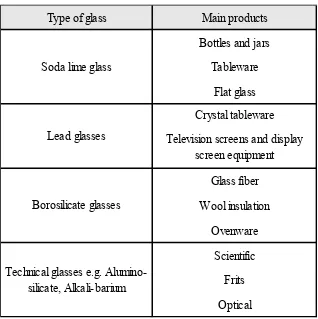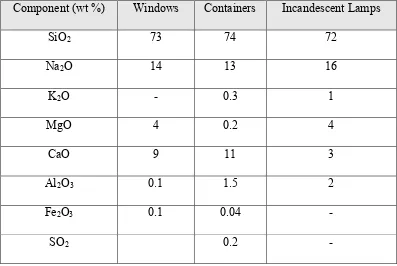UNIVERSITI TEKNIKAL MALAYSIA MELAKA
INVESTIGATION OF MECHANICAL AND MORPHOLOGICAL
PROPERTIES OF SPENT BLEACH EARTH (SBE) REINFORCED
GLASS WASTE COMPOSITE
This report submitted in accordance with requirement of the Universiti Teknikal Malaysia Melaka (UTeM) for the Bachelor Degree of Manufacturing Engineering
(Engineering Materials) (Hons.)
by
KHAIRIL AZWA BIN KHAIRUL B051110169
921013146153
UNIVERSITI TEKNIKAL MALAYSIA MELAKA
BORANG PENGESAHAN STATUS LAPORAN PROJEK SARJANA MUDA
TAJUK: Investigation of mechanical and morphological properties of spent bleach earth (SBE) reinforced glass waste composite
SESI PENGAJIAN: 2014/15 Semester 2
Saya KHAIRIL AZWA BIN KHAIRUL
mengaku membenarkan Laporan PSM ini disimpan di Perpustakaan Universiti Teknikal Malaysia Melaka (UTeM) dengan syarat-syarat kegunaan seperti berikut:
1. Laporan PSM adalah hak milik Universiti Teknikal Malaysia Melaka dan penulis. 2. Perpustakaan Universiti Teknikal Malaysia Melaka dibenarkan membuat salinan
untuk tujuan pengajian sahaja dengan izin penulis.
3. Perpustakaan dibenarkan membuat salinan laporan PSM ini sebagai bahan pertukaran antara institusi pengajian tinggi.
4. **Sila tandakan ( )
SULIT
TERHAD
TIDAK TERHAD
(Mengandungi maklumat yang berdarjah keselamatan atau kepentingan Malaysia sebagaimana yang termaktub dalam AKTA RAHSIA RASMI 1972)
(Mengandungi maklumat TERHAD yang telah ditentukan oleh organisasi/badan di mana penyelidikan dijalankan)
Alamat Tetap:
22, Jalan TU 31, Taman Tasik Utama,
Ayer Keroh, 75450
DECLARATION
I hereby declare this report entitled INVESTIGATION OF MECHANICAL AND MORPHOLOGICAL PROPERTIES OF SPENT BLEACH EARTH (SBE) REINFORCED GLASS WASTE COMPOSITE is the results of my own research except as cited in the references.
Signature :
APPROVAL
This report is submitted to the Faculty of Manufacturing Engineering of UTeM as a partial fulfillment of the requirements for the degree of Bachelor of Manufacturing Engineering (Engineering Materials) (Hons.). The member of the supervisory is as follows:
... Dr. Zurina Binti Shamsudin
i
ABSTRAK
ii
ABSTRACT
iii
DEDICATION
This report is dedicated to my respective parents; Mr. Khairul Bin Taib and Mrs. Faridah Binti Ahmad, my supervisor; Dr. Zurina Binti Shamsudin, my family’s members and also to all my friends who have been supported and inspired me to do this research study
iv
ACKNOWLEDGEMENT
Bismillahirrahmanirrahim, in the name of Allah, the most gracious and most merciful. First of all, I would like to extend my gratitude to Allah S.W.T. for His generous blessing and undying strength bestowed upon me during completing this research.
I would also like to express my gratitude to those who gave me the possibility to complete this PSM report. I am also grateful to Dr. Zurina Binti Shamsudin who had given me guidance and support for completing this research.Her enthusiasm, encouragement and faith in me throughout have been extremely helpful
v
List of Abbreviations, Symbols and Nomenclatures xiii
vi
2.1.3 Type of glass 5
2.1.4 Soda lime glass 6
a) Chemical composition 7
b) Characteristics 8
2.3.1 Definition of composite 10
2.3.2 Type of composite 10
2.3.3 Ceramic matrix composite 11
2.3.4 Studies on glass waste composite 12
2.4 Sintering 12
2.5 Properties characterization 13
2.5.1 Definition of properties characterization 13
2.5.2 X-ray Diffraction (XRD) 14
a) Working principle 15
2.5.3 Scanning Electron Microscopy (SEM) 15
a) Working principle 16
vii
a) Working principle 17
2.5.5 Flexural testing 18
a) Working principle 18
2.5.6 Density, Water absorption, and Porosity 19
2.6 Conclusion 20
3.3.4.1 Sintering profile 26
3.4 Properties characterization 28
3.4.1 Bulk density, porosity, and water absorption 28
3.4.2 Hardness test 30
3.4.3 Flexural test 30
viii
3.4.5 Scanning electron microscopy (SEM) 32
3.5 Conclusion 33
4. CHAPTER 4: RESULTS AND DISCUSSION 34
4.1 Physical properties analysis 35
4.1.1 Physical observation 35
4.1.2 Porosity, water absorption, and bulk density 36
4.2 Mechanical properties analysis 38
4.2.1 Microhardness testing 38
4.2.2 Flexural testing 39
4.3 Material characterization 41
4.3.1 X-ray diffraction (XRD) 41
4.3.2 Scanning electron microscope (SEM) 42
4.4 Conclusion 44
5. CHAPTER 5: CONCLUSION AND RECOMMENDATION 45
5.1 Conclusion 45
5.2 Recommendation 46
ix
7. APPENDICES 52
Appendix A
Data for XRD analysis Appendix B
x
LIST OF TABLES
2.1 Types and uses of the glass 6
2.2 Composition of common commercial soda lime glasses 7
3.1 The batches for the project 24
4.1 Physical observation for sample A, B, and C 35
4.2 The dry mass (D), suspended mass (S) and saturated mass (M) 36 for samples A, B, and C.
4.3 The hardness test results for sample A, B, and C 38
4.4 The modulus of rupture for sample A, B, and C 39
xi
LIST OF FIGURES
2.1 Classification of composite based on the shape of filler 11 2.2 XRD pattern for the glass composite material with different 14
bottom slag loading
2.3 SEM micrograph for sample 30%, 40%, 50%, and 60% 16 bottom slag
2.4 Illustration of SEM working principle 17
2.5 The three-point bend test 18
3.1 Flow chart of the experimental work 22
3.2 Sintering profile at 750°C with 2°C per minute for heating rate 26
3.3 Vickers microhardness machine 30
3.4 Schematic figure of sample testing 31
3.5 The rectangular mould of 65 mm x 15 mm x 4 mm 31
3.6 Scanning electron microscope, SEM 33
4.1 Apparent porosity and water absorption percentage for 37 samples A (30 wt.%), B (35 wt.%), and C (40 wt.%)
4.2 Bulk density for samples A (30 wt.%), B (35 wt.%), and 37 C (40 wt.%)
xii
4.4 Modulus of rupture for samples A (30 wt.%), B (35 wt.%), 40 and C (40 wt.%)
xiii
LIST OF ABBREVIATIONS, SYMBOLS AND
NOMENCLATURES
ASTM - American Standard Testing Material
CaO - Calcium Oxide
GPa - Giga Pascal
MOR - Modulus of rupture
MPa - Mega Pascal
Na2O - Natrium Oxide
SBE - Spent Bleach Earth
SEM - Scanning Electron Microscopy
SiO2 - Silicon Oxide, Coesite, Cristobalite
SLSG - Soda-lime silicate glass
XRD - X-ray Diffraction
Wt. % - Weight percentage
μm - Micron meter
1
CHAPTER 1
INTRODUCTION
1.1 Background of study
Waste has been a major environmental issue everywhere since the industrial revolution. The waste need to be managed carefully as it can be harmful to the people. One of the waste management method is recycling. Recycling is the processing of used products to attain materials that can be used to make a new products (Morgan, 2006). For example, the glass waste such as glass food and beverage container can be recycled over and over again. This recycle glass costs less than the raw materials, prolong furnace life and saves energy since it melts at a low temperature (Trzupek, 2010).
Another waste that may also be recycled rather than being exposed is Spent Bleach Earth (SBE). SBE is a solid waste generated from the palm oil refinery and usually is being simply disposed off in landfills. (Loh et al., 2013). The SBE waste can recycled and used as a filler in a ceramic composite material.
2
at fixed temperature. The sample will be further analyzed for the material’s properties which consist of mechanical properties with respect to their microstructure.
1.2 Problem statement
Nowadays, solid waste management is an important thing that need to be carried out as the solid waste can give the negative impact to environment. One of the major components of the solid waste is waste glass. Waste glass has become a considerable burden on the landfills throughout the world. Therefore, it is vital to find an ecological alternative to reuse and recycle the waste glass. Besides, the process of turning waste glass into usable products instead of discarding the glass is usually very advantageous.
It has been reported that recycle glass microstructural properties has contribute to the strong improvement of the mortar mechanical performance (Corinaldesi et al., 2005). The improvement on the mechanical properties is attractive for replacing conventional materials.
3
1.3 Objectives
The main objective of this research was to study the mechanical properties and morphological properties of the glass waste composite. The study objectives include:
i. To determine the ideal composition of the soda lime silicate glass (SLSG) waste with addition of spent bleach earth (SBE) at a fixed sintering temperature.
ii. To characterize the physical and mechanical properties of the glass composite sample.
iii. To analyze the correlation of phases, microstructure and mechanical properties of the glass composite sample.
1.4 Scope of study
4
CHAPTER 2
LITERATURE REVIEW
This literature review provides an overview of the glass waste and natural waste. It covers the inclusive review on the material properties and their constituent. Furthermore, the characterization methodologies are also included in this literature review. It comprises the scanning electron microscopy (SEM), X-ray diffraction (XRD), flexural test, and Vickers microhardness test and density measurement.
2.1 Glass waste
2.1.1 Definition of glass
5
In another view, glass is created from natural and abundant raw material of sand, soda ash and limestone. The raw material is melted at very high temperature to form glass. Glass is structurally similar to liquids at high temperature though behave like solid at ambient temperature. This characteristic make glass can be poured, press and molded into various shapes (Glass Alliance Group, 2012).
2.1.2 Definition of glass waste
Glass waste is the glass product that has been discarded or no longer in use. Waste glass disposal come from glass container, flat glass and domestic glass is one of the major environmental challenges. It becomes more challenging as the quantity of waste glass increase and reducing the landfill space capacity (Rashad, A. M., 2014).
Therefore, glass product need to be reused or recycled so that environmental problems can be avoided (Ali, E.E., 2012).
2.1.3 Type of glass
6
Table 2.1: Types and uses of glass (Siddique, 2008)
2.1.4 Soda-lime glass
7
Technically, soda-lime glass can be divided into glass used for windows and glass for containers which are called float glass or flat glass and container glass respectively. Both types vary in the application, chemical composition and production method (Reade, 2014).
a) Chemical composition
Soda-lime glass typically contains 71 to 75 percent of silicon dioxide (SiO2), 12 to 16 percent sodium oxide (Na2O), 10 to 15 percent calcium oxide (CaO) and small quantities of other substances such as dyes (Bvglas.de, 2014). Table 2.2 shows the typical compositions of commercial soda lime glasses.
Table 2.2: Compositions of common commercial soda lime glasses (Shelby, 2005).
Component (wt %) Windows Containers Incandescent Lamps

